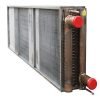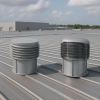Ever wonder why HVAC coils use copper tubes and aluminum fins? It’s no accident.
Copper is a great conductor of heat, so it works great for the tubes. Aluminum is also effective for heat transfer, but it’s not as good as copper. Instead, aluminum is the perfect choice for fins. The combination of copper and aluminum provides the best heat transfer at an efficient cost.
Heat transfer and cost are the two most important considerations when selecting an HVAC coil for a specific application. This is why copper and aluminum are the perfect duo!
Copper works excellent for the tubes but doesn’t work as well for the fins. While there are some situations to use a copper fin, most HVAC coils are made up of copper tubes and aluminum fins. In our experience, this seems to be the most effective combination.


What are fins?
Fins are the secondary surface, while tubes are known as the primary surface. This is because the tubes are expanded into the fins, making them secondary. Even though fins are called the “secondary” surface, their heat transfer capacity is twice the amount of the tubes!
Fins account for 65%-70% of heat transfer on coils, while tubes account for 30%-35%. It’s essential to have a strong fin/tube bond for your coil to perform optimally.
Understanding HVAC Coils
It’s important to understand the different materials used for HVAC coils. Coils can be built with many materials ranging from steel to nickel, but none are as cost-effective as the copper/aluminum combination.
Mainstream’s team of experts is ready to help you with all of your coil selection needs. Contact us today for a quote, and let us help you with your next project!





